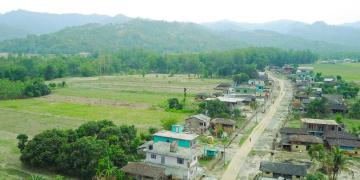Jaguar and biodiversity monitoring
photo of a small jaguarundi feline, in one of the farms of Agua Buena.
Ricardo Moreno, Fundación Yaguará Panamá
One of the interesting aspects of this project is to measure the biodiversity in each of the farms and to know how many jaguars there are or cross the farms. For this we monitor them with camera traps. As each jaguar has unique spotting patterns for each individual, it is possible to know how many there are and record when they are in the different farms. In addition, we combine the camera traps with GPS collars that we place on the jaguars on the farms to know where they move, how many farms they visit and how much time they spend on the farm. This helps us understand the jaguar dynamics in an environment dominated by cattle ranchers and forest corridors between farms.
With the data from the camera traps and GPS collars we have been able to give the community a better understanding of the jaguar and why it is an important species for the ecosystems and for our own existence as human beings.
Based on the information collected we can measure indicators such as: number of jaguars per year and abundance of other mammals that are important prey for the jaguar, and we can help local and national decision makers and farm management decision makers.
Through photos, footprints and tracking of jaguars we began to create empathy between the community and the animals that move within the farm.
This empathy generates that the people of the community are concerned about the safety of the jaguars they know.
We are conducting scientific research hand in hand with the people of the community. By knowing how many jaguars there are in the area, they have valuable information that can be used for community tourism.
Long-term monitoring is the best way to understand the jaguar and the dynamics of the community.
We at Yaguará Panama always say that "the real and final destiny of conservation is in the hands of the people who live directly with nature". Projects should always be carried out with a high percentage of people from the communities where the project is carried out. If there is no continuity with funds to continue, it is likely that if there is a good foundation some of the community members will take the step to be better and have coexistence with nature.
Having photos gives a face and sometimes even a name to the animals and this generates a positive feeling to take care of the jaguar and the environment in general.
Always keep the community informed about the results of scientific studies in the area, this is fundamental.
And again, this interaction generates trust and if there is trust in these contexts, it is possible that they will continue with the agreement. Try as much as possible to keep the community always excited about what is being done, if you don't do this, they may lose follow up and disappear.
